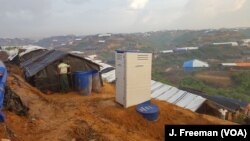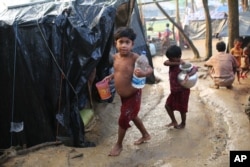Standing next to newly erected tents clustered on a hillside, Abdul Malek explains one of the biggest problems facing the more than 500,000 Rohingya Muslims who fled violence in Myanmar for the relative safety of Bangladesh.
Finding a bathroom
“Until three days ago, we faced many difficulties with the toilet,” said Malek, a Rohingya man from Myanmar’s northern Rakhine State, where fighting erupted on Aug.25 when the Arakan Rohingya Salvation Army attacked security forces, prompting an exodus over the border that a top United Nations Human Rights official called a textbook example of ethnic cleansing.
By “many difficulties,” Malek meant there was no toilet, and answering nature’s call involved wandering down into a field below. In the past week, however, a new latrine was installed by the U.N. refugee agency.
Though the toilet serves the needs of hundreds of people, creating long lines in the morning, it’s better than nothing.
“Now, it’s okay,” he said.
As Rohingya continue to pour into refugee camps and whatever open land can be found in Cox’s Bazar district in southern Bangladesh, fears of waterborne diseases such as cholera, which can spread through contaminated drinking sources, are growing by the day.
The problem is compounded because the camps and new settlements are heavily congested areas with large numbers of children who have weakened immune systems.
To help combat a potential health emergency, aid groups are hurriedly installing thousands of tube wells for clean drinking water and as many latrines as they can.
Asif Saleh, a senior director with the Bangladeshi relief organization BRAC, said it was targeting installation of 15,000 latrines by Oct. 15.
He said building temporary facilities that may last only a month was more important than constructing permanent structures, as the current settlements themselves are not permanent. So far it has set up 4,600 latrines.
“We need to get people to use toilets, as fast as we can, as much as we can expand, that is the goal, rather than doing longer-term initiatives, which will take much longer to do per toilet,” he said. “I think the biggest typical emergency situation risk is on health risks. And a lot of the diseases spread from open defecation and not having access to clean water. Currently we have the risk that cholera might break out.”
Health concerns
Cholera has not been detected yet, but there are other worrisome signs regarding sanitation-related health problems.
The number of patients visiting BRAC’s mobile clinics with diarrhea and dysentery has risen from two percent to almost 20 percent, Saleh said.
Vivian Tan, a spokesperson for the United Nations High Commissioner for Refugees, said in an email that to date the organization and its partners have installed 500 latrines serving some 25,000 people, mainly in the now-extended section of the Kutupalong camp. UNHCR has also installed tube wells providing nearly 37,000 refugees with access to clean water.
“The work is ongoing amid land constraints and we hope to improve the ratio of facilities accessible to each family as soon as we can,” Tan said.
An additional safeguard for controlling the spread of cholera is vaccination.
With support from the World Health Organization and the United Nations Children's Fund, Bangladesh’s Ministry of Health rolled out an ambitious oral cholera vaccination campaign on Tuesday at many of the settlement sites in the Cox's Bazar sub-districts of Ukhia and Tekhnaf.
According to UNICEF spokesperson Jean-Jacques Simon, 900,000 doses of the vaccine are in the process of being delivered by mobile teams, and the drive represents the second-largest oral cholera vaccination campaign ever, the first being in Haiti last year.
Simon noted that in the last week alone, nearly 10,300 new cases of diarrhea have been reported.
The initial phase of the vaccination campaign will target more than 650,000 people aged one year and older, while the second part will begin at the end of this month and aim to cover some 250,000 children between the ages of 1 and 5.
But the scope of the humanitarian response and the changing situation on the ground can sometimes brush up against unexpected realities.
For Malek and his neighbors, the installation of the new latrine helped, but not everyone is using it. He explained that the families living in tents surrounding the toilet had recently decided that it would be for women only because they need more privacy.
When asked where men go, he gestured towards the hills and fields.
“We’re men, we can go anywhere,” he said.









